Deciding what to wear in Saudi Arabia can puzzle female tourists. Since 2019, the country has relaxed its dress code for women, requiring modesty but not enforcing abayas or headscarves everywhere.
This article provides five key steps to master the local dress code with ease and confidence. Get ready to blend in respectfully!
Key Takeaways
Female tourists in Saudi Arabia should wear modest clothing like Abayas, covering arms and legs. Since 2019, it’s not a must to wear an Abaya but advised for respect.
Different regions in Saudi have their own dress code preferences, with Riyadh favoring more conservative attire while Jeddah is more relaxed. Always respect local norms.
Light fabrics are best due to the heat, and wearing simple jewelry aligns with local customs. Closed-toe shoes are suitable for formal places.
At religious sites, women should cover their hair with a scarf or shawl. In offices and formal meetings, long dresses or skirts paired with blouses fit the culture.
An Abaya does not limit style; colorful scarfs or belts can add flair. Underneath, comfortable clothes like jeans or T-shirts work well for staying cool and respecting modesty.
Table of Contents
Navigating Dress Code Norms for Female Tourists in Saudi Arabia
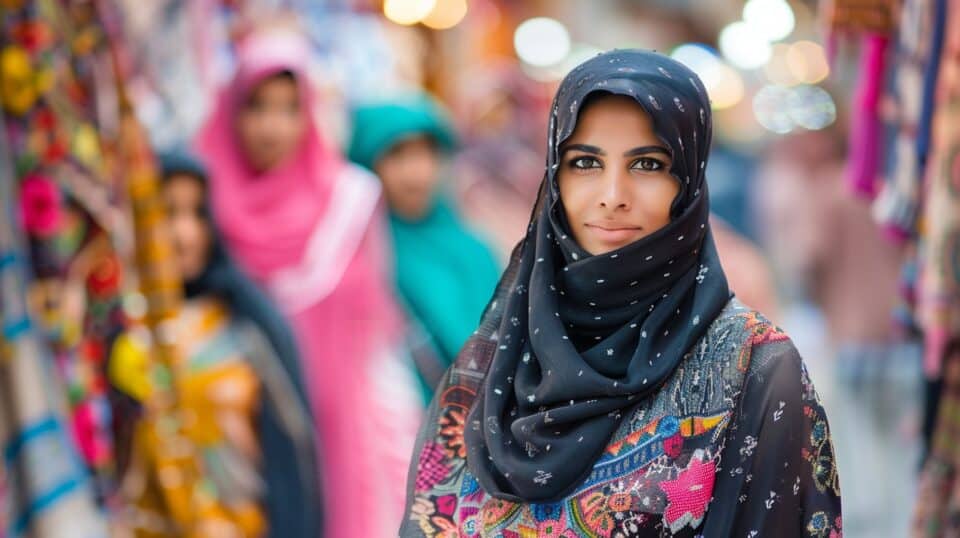
Dressing right in Saudi Arabia means learning their culture’s clothing rules. Before you fly with Saudi Airlines, know that wearing an Abaya and modest clothes is key.
Saudi cultural norms and attire requirements
Saudi Arabia values modesty in dress. Women usually wear long robes, known as Abayas, with headscarves called Hijabs outside their homes. The law changed in 2019, allowing foreign expats to skip the Abaya, but still advises dressing modestly.
This means outfits should cover arms and legs and avoid showing too much skin or having inappropriate images or text.
Breaking the dress code might just get stares, not legal action.
Visitors must respect these norms everywhere— from Riyadh’s busy streets to Jeddah’s Red Sea coast. While religious police can’t enforce rules on tourists, it’s wise to follow local customs for a smooth visit.
Essentials include loose-fitting pants, long skirts, maxi dresses for women, ensuring shoulders and knees are covered.
Essentials of wearing Abayas and modesty
Wearing Abayas shows respect for Saudi culture. Women find them in various colors like dark green, blue, purple, and gray, besides the traditional black. Online platforms like Modanisa offer them internationally.
Yet, buying locally at Saudi malls gives good deals with prices no more than 100 SAR (~£20.00). They are practical too; one Abaya is enough for a 2-3 week trip since they wash easily.
Under an Abaya, normal clothes such as jeans or a t-shirt work fine. This flexibility means comfort does not have to be sacrificed for modesty. Abayas blend tradition with modern needs seamlessly—providing both coverage and style while respecting local customs.
Dress Code Variations Across Saudi Regions
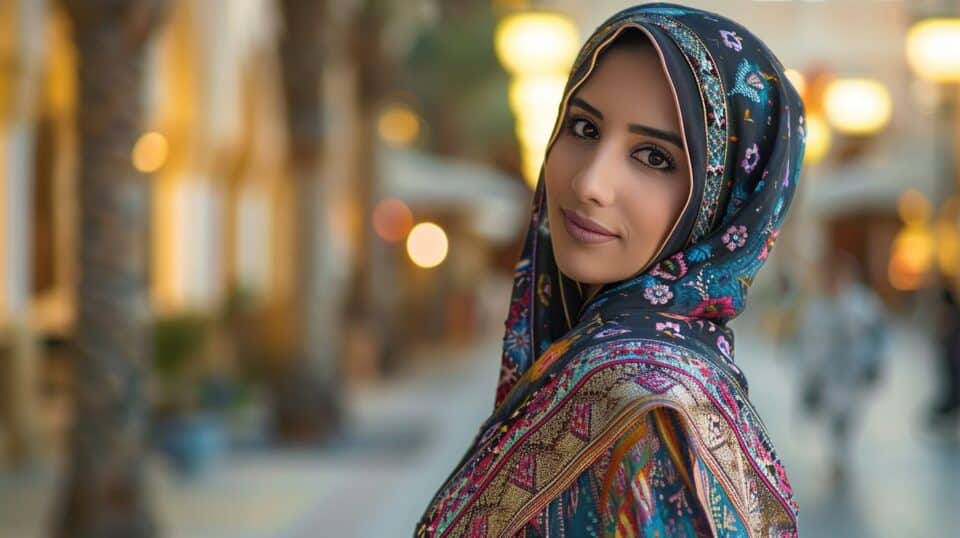
Saudi Arabia’s dress code changes from place to place. What you wear in Riyadh might not fit in Jeddah or the coastal areas, and AlUla asks for different styles too.
Attire recommendations for Riyadh
In Riyadh, women often wear long tunics or shirts that cover their hips with long sleeves. Pair these with loose trousers for a respectful and comfortable outfit. Black abayas are common; however, you can choose ones in other colors too.
Always opt for modest clothing that doesn’t show your shape too much.
I found wearing an abaya easy to blend in at places like malls and restaurants. Shoes should be comfortable—flats work best, since you might walk a lot on uneven pavements. For visiting government buildings or religious sites, cover your hair with a scarf out of respect.
It’s less about strict rules and more about showing respect for local customs.
Suitable outfits for Jeddah
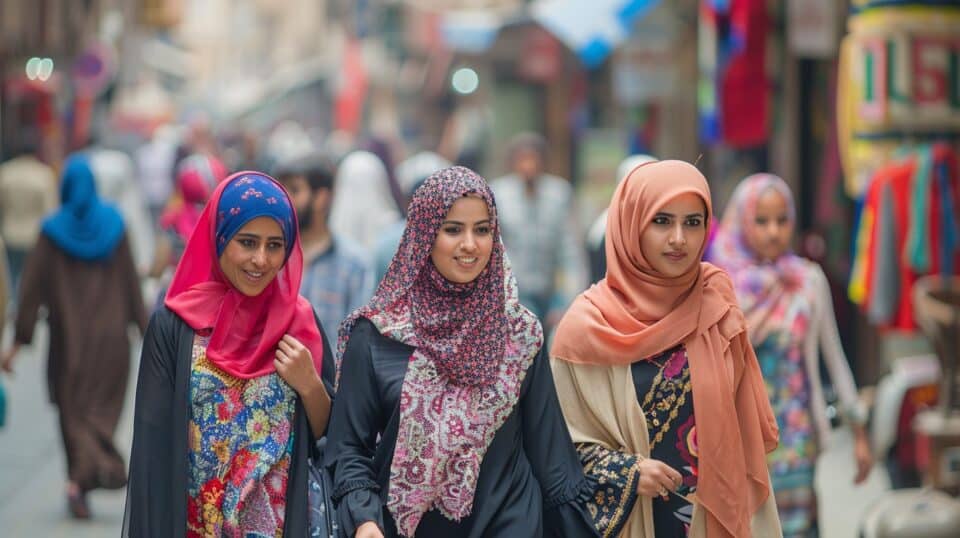
Jeddah’s vibe is more relaxed, making it okay for female tourists to wear loose, long dresses or skirts that go past the knees. Abayas are common, but not always a must. Light fabrics like linen keep you cool in the heat.
Tops should cover shoulders and be modest. Jeans and T-shirts are fine if they’re not too tight.
For footwear, sandals work well because of the warm weather. Just remember to stay respectful with what you choose to wear outdoors. Beaches near Jeddah allow swimsuits within private resorts or women-only beaches; a burkini is a good choice for public spots.
Fashion adapts to culture and climate—Jeddah’s relaxed dress code embraces both.
Next up: Choosing clothes for Dammam and Khobar brings another layer of cultural insights.
Choosing clothes for Dammam and Khobar
In Dammam and Khobar, women have options beyond the traditional black Abaya. You can wear long-sleeved tops and baggy pants or skirts that reach your ankles. Dark green, blue, purple, and gray are all good color choices for Abayas here.
While in these cities, I noticed many locals and tourists opting for vibrant hues, showing a bit more personality through their attire.
Shorts are not common for both men and women in Dammam and Khobar – it’s best to leave them at home. For footwear, comfortable shoes like flats or sneakers work well since you might walk a lot during your visit.
Remember to dress modestly to respect local customs, but feel free to incorporate some color into your wardrobe.
Appropriate wear for AlUla and Abha
In AlUla and Abha, it’s all about dressing smartly for the weather while respecting local customs. Lightweight, long-sleeved tops and loose pants work best. The heat can be intense, but these clothes keep you cool and fit right in with the cultural norm of modesty.
Always carry a shawl or scarf; they’re handy for covering your hair if needed.
Exploring these areas showed me that choosing breathable fabrics makes a huge difference. Outfits like maxi skirts paired with blouses are perfect. They offer freedom to move and keep you comfortable during long walks through historical sites or when enjoying the cool highland air in Abha.
Remember, comfort pairs well with respect here—opting for modest clothing shows understanding of Saudi customs.
Appropriate Attire for Specific Contexts
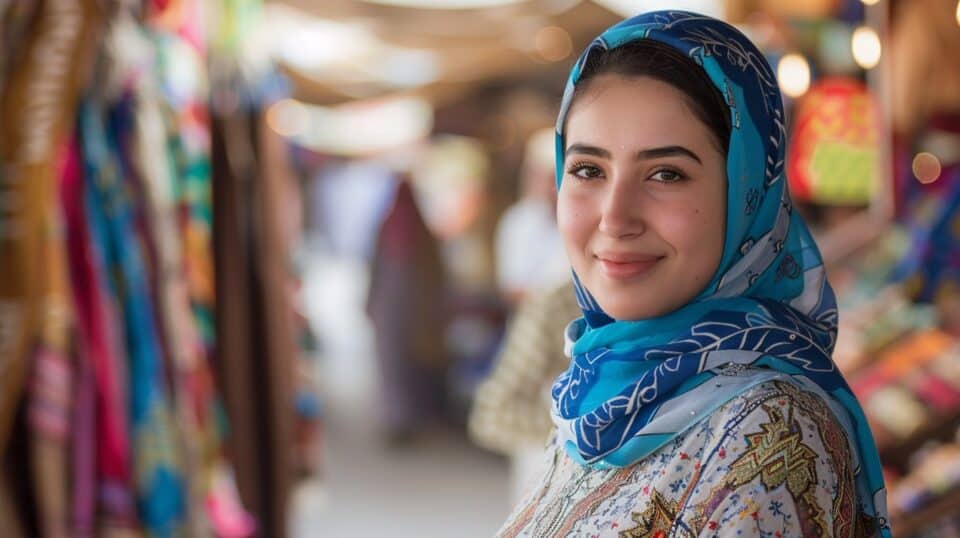
Knowing what to wear matters a lot in places like mosques, airports, and offices… Keep reading to get smart with your outfit choices.
Dress codes for religious sites
Covering your hair is a must at mosques. You should also skip wearing any religious symbols that aren’t Islamic. This shows respect and follows the rules. Outfits need to be modest, covering arms and legs fully.
Think long sleeves and pants or skirts that go down to the ankles. These small steps ensure you honor local traditions and can visit these sacred places without issues.
Choose clothes that are loose and made from breathable fabric, especially during hot months. Light colors are better as they don’t absorb heat like dark ones do. For women, wearing a scarf or shawl can easily cover your hair when entering a mosque.
Men should wear long trousers with shirts covering their shoulders.
What to wear at Saudi airports
At Saudi airports, women must dress modestly. Long tops, pants or skirts that cover the knees are ideal. Abayas are not required for non-Saudi females but wearing one shows respect for local customs.
Always choose light, breathable fabrics due to the country’s hot climate.
From my experience flying into Jeddah airport, pairing a loose-fitting long sleeve shirt with ankle-length trousers worked well. It kept me comfortable and aligned with cultural norms.
Shoes should be easy to remove, as you might need to do so at security checks. Flip-flops or slip-on shoes are smart choices. For those wondering about headscarves, they’re not mandatory in public spaces for non-Muslim women but keeping one handy is wise in case it’s needed at certain sites connected to the airports.
Office attire for expatriate women
In Saudi Arabia, expatriate women often wear long dresses or skirts paired with blouses for work. These outfits cover the arms and legs well, respecting local customs. Choosing black Abayas is traditional but now, colors like grey and navy are also popular in offices.
For meetings or formal events, adding a jacket over your dress can polish your look. My colleague always pairs chic trousers with modest tops for a professional vibe. Remember to select shoes that are both smart and comfortable for long workdays.
Accessories like simple jewelry elevate the office attire while keeping it respectful of cultural norms.
Tips for Female Tourists on Clothing and Etiquette
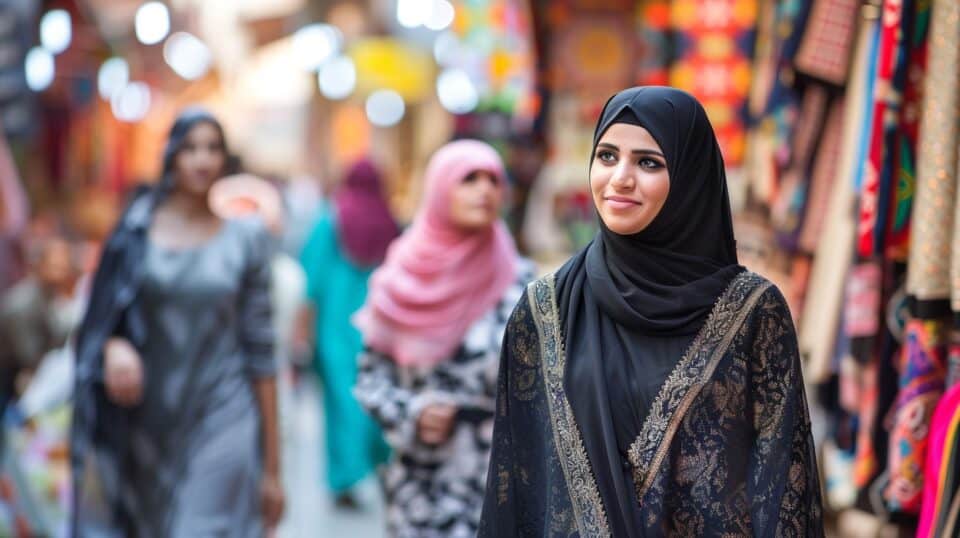
Dressing right shows respect for Saudi culture…and, well, it keeps you out of trouble. Think simple: Abayas outside, comfy clothes inside—plus a headscarf always handy.
Deciding on hair coverage
Foreign women can choose not to cover their hair in Saudi Arabia. This rule is clear—no need for a headscarf unless visiting a mosque. Always carry a shawl or scarf, just in case you decide to enter religious sites.
Next, think about what shoes to wear in this country.
Selecting footwear in Saudi Arabia
In Saudi Arabia, choose light, breathable shoes because of the heat. Closed-toe options work best for formal places. Stay away from casual flip-flops in public. This advice comes from my own trips there.
I found walking in markets and visiting museums more comfortable with sturdy sandals or sneakers.
Next up, we talk about guidelines for wearing jewelry and accessories.
Guidelines for wearing jewelry and accessories
Keep jewelry simple and minimal. Avoid flashy or large pieces. Small earrings, a watch, or a thin bracelet work well. This aligns with local customs and shows respect for Saudi norms.
Avoid religious symbols from any faith other than Islam.
From personal experience, blending in means choosing accessories wisely. Neymar faced criticism for his earrings and crucifix necklace—it’s clear, conspicuous religious symbols can draw unwanted attention.
Stick to understated items that don’t stand out too much.
Considerations for Wearing an Abaya
Picking the right Abaya depends on comfort and style… Don’t forget, wearing something beneath that keeps you cool is key.
Choosing styles and tips for Abayas
For Abayas, light fabrics work best in Saudi’s heat. Look for choices that breathe well, like cotton or linen. They keep you cool and fit the modesty rule. Markets sell them for less than 100 SAR (~$27).
I found long-sleeve tops perfect underneath to stay respectful yet comfortable. Mixing styles is okay too. You can wear colorful scarfs or belts with a plain Abaya to add some flair without breaking rules.
Comfort is key, so pick an Abaya size that allows easy movement. Tight ones are not only hot, but also restrict walking or sitting. Many shops offer various sizes and cuts – A-line shapes tend to be airier and more flattering for different body types.
Wearing baggy clothes under your Abaya isn’t just about following customs; it’s about feeling good while exploring Saudi Arabia’s rich culture and landscapes.
Options for undergarments with an Abaya
Under an Abaya, wear 3/4 length pants, jeans, or a T-shirt for comfort and modesty. Choose lightweight undergarments to stay cool in the hot climate. Bulky layers don’t work well; they add discomfort.
I find that leggings and simple cotton tops keep me comfortable and covered under my Abaya.
Avoid too many layers. A single layer of clothing is enough for both modesty and heat management.
Managing comfort and style in the heat
In Saudi Arabia, the summer heat demands clever clothing choices to stay cool and look good. Lightweight, breathable fabrics like cotton and linen are essential. They allow air to circulate, helping your body keep a comfortable temperature.
Long-sleeved tops and loose-fitting clothes not only respect local customs but also shield your skin from the sun.
I always choose light colors because they reflect the sun’s rays better than dark ones. A lightweight fleece or cardigan is a must-have for indoor places with air conditioning—from April to November, these can be real lifesavers against sudden chills.
Pairing an abaya with airy undergarments ensures comfort without compromising on style or modesty. Shoes that slip on and off easily make navigating through mosques and traditional homes hassle-free, while keeping feet cool in sandals is smart for beach areas like Jeddah.
FAQs About What Female Tourists Should Wear in Saudi Arabia
What should female tourists wear in Saudi Arabia?
In Saudi Arabia, women must dress modestly: long dresses or abayas that cover the body, and a headscarf for public places. It’s not just about following the law; it’s respecting local customs.
Can I wear Western clothes in Riyadh or Jeddah?
Yes, but with caution. Opt for loose-fitting items that cover knees and shoulders. Cities like Riyadh and Jeddah are more lenient, especially in private resorts where swimwear is allowed.
Do I need to wear a niqab or burka during my visit?
No, you don’t have to wear a niqab or burka. A headscarf suffices for most places except religious sites like Mecca and Medina where more conservative attire is expected.
How can I stay cool while dressing conservatively in the heat?
Choose breathable fabrics like cotton or linen for your abaya or dress. Light colors reflect sunlight, helping you stay cooler under the hot sun.
Is there any clothing item absolutely off-limits?
Yes, avoid anything too tight, transparent, or revealing such as miniskirts and tank tops to respect local norms and laws on modesty.
What happens if I don’t follow these dress codes?
Not adhering to the dress code could attract unwanted attention from locals or even lead to intervention by morality police (mutaween), emphasizing the importance of dressing appropriately.



